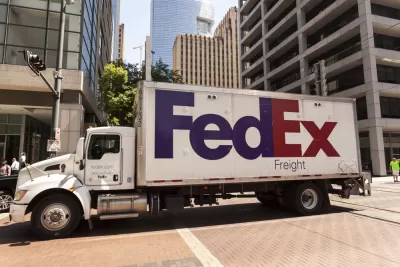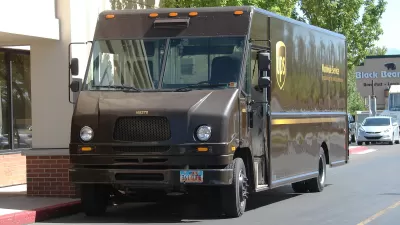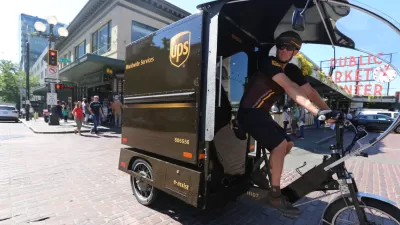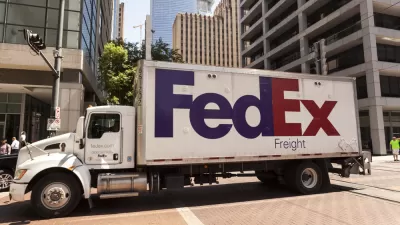Urban freight deliveries are expected to grow 40 percent by 2050, according to the 2017 Material Handling Industry’s annual report. Cities aren't yet ready to keep up with the changing times.

Emma Kantrowitz surveys the landscape of U.S. policy for examples of cities effectively responding to increased urban freight deliveries and finds only a few examples to choose from.
New York would seem to have more reason than any city in the United States to deal with the challenges of curbside delivery and increase freight traffic on city streets. So far, the city's response includes a Smart Truck Management plan in the works at the New York City’s Department of Transportation. Also, "the DOT has already implemented their Off-Hour Deliveries program, which encourages deliveries between 7 p.m. and 6 a.m. to help relieve midday congestion," according to Kantrowitz.
Another example is found in Seattle, where "UPS is testing delivery by electric bicycle, which can haul up to 400 pounds in large, preloaded crates. The eBike service leaves more room for deliveries on already crowded streets, helps reduce carbon emissions and is already available in over 30 cities globally."
"The Seattle launch is the first permanent program in the U.S.," according o Kantrowitz.
One ongoing challenge limiting the adoption of targeted programs designed to mitigate the impacts of increased shipping and delivery demand in urban areas.
For more on the same subject in recent years, here's a sample of articles from the Planetizen archive:
- FedEx Testing Electric Tricycles for Deliveries (August 2010)
- Bikes Emerge as a Viable Alternative for Urban Freight (October 2013)
- Urban Amenity: Pick Up UPS Packages at the Dry Cleaner or Pharmacy (October 2014)
- Online Retail Curbs Urban Traffic (September 2015)
- Quick Internet Delivery Services Clog City Streets with Delivery Trucks (December 2016)
- Explosion of Deliveries Disrupts Streets (June 2017)
- Addressing Online Retail's Ceaseless Curbside Deliveries (January 2018)
- Do Rideshare and Goods Delivery Need Their Own Curb Space? (February 2018)
FULL STORY: How Cities Are Evolving to Meet the Sharp Rise in Shipping Demands

Planetizen Federal Action Tracker
A weekly monitor of how Trump’s orders and actions are impacting planners and planning in America.

Maui's Vacation Rental Debate Turns Ugly
Verbal attacks, misinformation campaigns and fistfights plague a high-stakes debate to convert thousands of vacation rentals into long-term housing.

Restaurant Patios Were a Pandemic Win — Why Were They so Hard to Keep?
Social distancing requirements and changes in travel patterns prompted cities to pilot new uses for street and sidewalk space. Then it got complicated.

In California Battle of Housing vs. Environment, Housing Just Won
A new state law significantly limits the power of CEQA, an environmental review law that served as a powerful tool for blocking new development.

Boulder Eliminates Parking Minimums Citywide
Officials estimate the cost of building a single underground parking space at up to $100,000.

Orange County, Florida Adopts Largest US “Sprawl Repair” Code
The ‘Orange Code’ seeks to rectify decades of sprawl-inducing, car-oriented development.
Urban Design for Planners 1: Software Tools
This six-course series explores essential urban design concepts using open source software and equips planners with the tools they need to participate fully in the urban design process.
Planning for Universal Design
Learn the tools for implementing Universal Design in planning regulations.
Heyer Gruel & Associates PA
JM Goldson LLC
Custer County Colorado
City of Camden Redevelopment Agency
City of Astoria
Transportation Research & Education Center (TREC) at Portland State University
Jefferson Parish Government
Camden Redevelopment Agency
City of Claremont





























